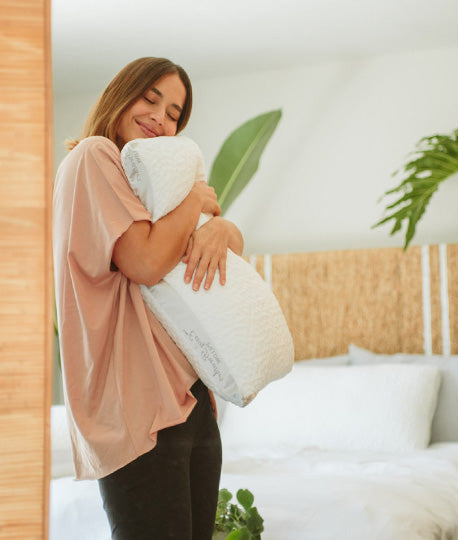How Hypoallergenic Bedding Can Help You Find Allergy Relief

24.4 million Americans suffer from seasonal allergies each year. If you are one of those millions of people, you know the struggle of itchy eyes, a runny nose, and a scratchy throat. You may have even worse symptoms like headaches, fatigue, and asthma during allergy season.
Unfortunately, allergy season is getting longer with each passing year. That means more time dealing with the symptoms of spring allergies. If your allergies are so bad that your symptoms negatively impact your sleep, a longer allergy season can feel never-ending.
But did you know that hypoallergenic bedding can help provide you with some allergy relief? Believe it or not, regular bedding attracts certain allergens that contribute to your allergy symptoms.
By investing in hypoallergenic bedding, you can ease some of your symptoms and get a better night’s sleep during allergy season. Keep reading to learn about why this bedding works so well and why it’s worth making the switch!
What Allergens Typically Exist in Beds?
It’s not pleasant to think about allergens living in your bed, and many people never really do think about it. You can’t see them, but if you have seasonal allergies they are most likely messing with your sleep. Understanding the types of allergens listed below that might be in your bed is an important piece of figuring out how to eliminate them.
Dust Mites
Dust mites are virtually everywhere. They are tiny microscopic bugs that feed on dead human skin cells found in dust. The allergen that dust mites create is one of the biggest triggers for people with allergies and asthma.
Mold
The average adult loses 10 ounces of fluid a night. Mattresses soak up most of that sweat which causes mold and mildew growth. Both of these can contribute to allergic reactions or other breathing issues for some people.
Pet Dander
Any pet lovers out there that let their pets in their beds may be exposing themselves to even more allergens. Beyond pet dander that causes reactions for those who are allergic to it, pets can bring in other outdoor allergens. That includes things like mold spores, dead skin cells from other animals, and pollen.
Pollen
Even if you don’t have pets, pollen can still end up in your bed. During spring allergy season, pollen gets everywhere. It gets stuck in our hair, on our clothes, and in the air. It’s possible for you to unknowingly transfer pollen to your bed.
What is Hypoallergenic Bedding?
Simply put, hypoallergenic bedding is bedding that is designed to lessen exposure to allergens. It’s made from materials that are proven to reduce allergens. It is much less likely to cause allergic reactions than non-hypoallergenic bedding.
Hypoallergenic bedding can be designed in various ways and made out of different materials. Two of the most popular materials used are synthetic materials and wool, which each reduce allergens in different ways.
Synthetic Materials
Hypoallergenic bedding made with synthetic materials traps allergens within the bedding. That means they can't be dispersed and cause an allergic reaction. The tight weave of synthetic material is perfect for trapping allergens.
Natural Materials
Natural materials like wool and organic cotton are capable of repelling certain allergens like dust mites. It creates a cool, dry environment in which allergens can’t survive. This keeps allergens away from your bedding and is the ideal option for people looking to eliminate allergens from their bed.
How You’ll Get Better Sleep with Hypoallergenic Bedding
Now that you know what types of allergens live in your bed, you can appreciate how much they can negatively impact your sleep. Knowing which types of allergens you react to and what bedding swaps to make will help you reduce the number of allergens in your bed.
Pillows and Pillow Cases
Pillows that are filled with down or feathers are a breeding ground for allergens. You should consider replacing those pillows with synthetic materials like polyester or memory foam. These types of pillows are anti-microbial.
You’ll also want to think about switching to hypoallergenic pillowcases. Pillowcases made from latex or silk are resistant to mold and mildew. You can rest easy knowing that you’re protected from these types of allergens.
Comforter
Similar to pillows, it’s best to avoid comforters made of down or feathers. For the best barrier against allergens, look for a comforter made out of wool, silk, or organic cotton with a high thread count. The high thread count ensures a tight weave which prevents allergens from being able to live inside your comforter.
Mattress Cover
If you’re highly allergic to dust mites, a hypoallergenic mattress cover is essential. A mattress cover made of a tight weave makes it impossible for dust mites to pass through. That means they won’t be able to move into your mattress, which drastically reduces the number of dust mites around your bed.
Look for a hypoallergenic mattress cover that is easy to put on and take off your bed. You’ll also want to make sure it won’t shrink in the washing machine or dryer.
Sheets
Hypoallergenic sheets are designed to repel allergens like pollen, dust mites, and mold spores. They are usually made out of a synthetic material that is designed to repel rather than absorb particles. It’s easier to shake out and wash out allergens from hypoallergenic sheets than regular cotton.
Ready to Make the Switch?
Hypoallergenic bedding materials are proven to reduce or eliminate allergens. If you suffer from seasonal allergies, hypoallergenic bedding can help give you symptom relief at bedtime.
Now that you know how it works, are you ready to toss out your old stuff and make the switch to hypoallergenic bedding? It's a great way to combat your allergy symptoms and get your sleep back on track!




